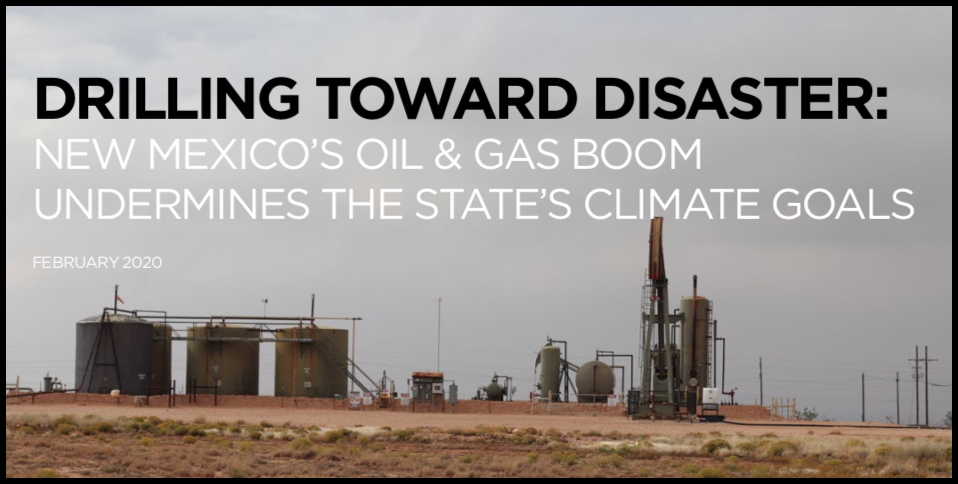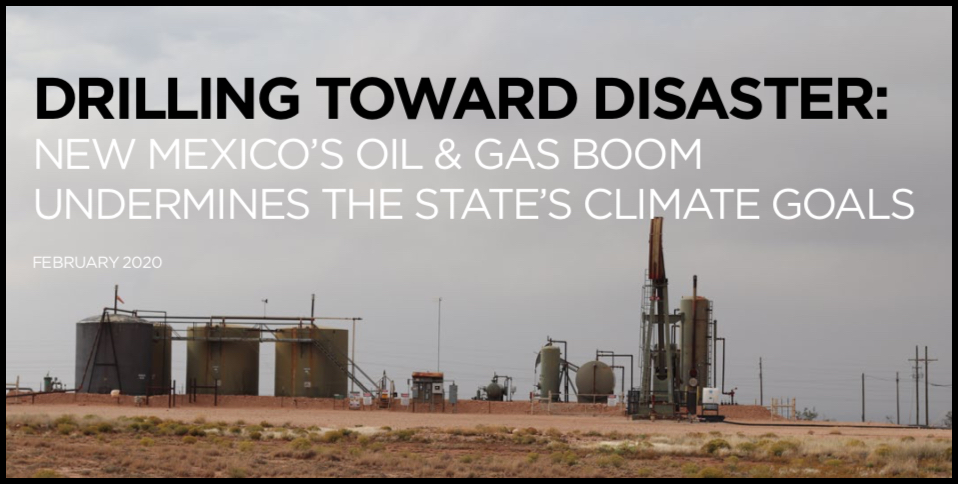
Published by Oil Change International.
Endorsed by EarthCare, New Energy Economy, Physicians for Social Responsibility, WildEarth Guardians, and Youth United for Climate Crisis Action.
February 2020
A new briefing from Oil Change International compares New Mexico’s oil and gas boom with the state’s goals to reduce climate emissions. It shows how the projected increase in New Mexico’s oil and gas production is entirely out of sync with the action necessary to prevent catastrophic climate change.
We find that New Mexico cannot meet its commitment to global climate goals if it allows a massive expansion in oil and gas production, exporting new emissions outside of the state.
The briefing’s key findings include:
- Since 2010, New Mexico’s oil and gas production has grown 125%, to just under 2 million barrels of oil equivalent per day in 2019. Oil and gas production is expected to grow an additional 85% by 2030.
- From now to 2030, over 70% of New Mexico’s oil and gas production will come from wells that have not yet been drilled. We call this ‘undeveloped’ oil and gas.
- In 2030, annual carbon dioxide (CO2) emissions from burning New Mexico’s oil and gas will reach over 550 million metric tons per year (MMT/yr), the equivalent of 141 coal plants.
- In 2030, 86% of projected emissions — 478 MMT — will come from burning currently undeveloped oil and gas. This is equivalent to the annual emissions from 123 coal plants, and over 10 times Governor Michelle Lujan Grisham’s target for in-state emissions in 2030.
New Mexico cannot expect other states and countries to follow its example in reducing emissions if it continues to push an increasing amount of fossil fuel into the global market. Only a managed and equitable phase-out of oil and gas production, while protecting and supporting workers and communities along the way, can achieve the governor’s commitment to meet the goals of the Paris Agreement.
CLICK HERE TO DOWNLOAD THE FULL BRIEFING
Notes:
- For more information on the future of oil and gas drilling in the context of New Mexico’s and the United States’ climate goals, read our 2019 Drilling Towards Disaster report: https://priceofoil.org/2019/01/16/report-drilling-towards-disaster/
- A press conference will take place in Santa Fe, New Mexico on Thursday, Feb. 13, 2020, at 2pm MT / 4pm ET, and can be watched live on our Facebook page: https://facebook.com/priceofoil


I look forward to reading the NM report. I was really impressed with the Jan. 2019 report that covered the U.S. As far as GHG emissions accounting at the state level, are you suggesting that the accounting be done with respect to where the fossil fuels are extracted rather than where they are actually used by consumers? It’s my understanding that is the opposite of how most states (and I believe countries via the UN process) do GHG emissions accounting. While I totally support your emphasis on needing to directly go after fossil fuel extraction via “managed decline”, I think it is a mistake to assign GHG emissions to states based on where the fossil fuels are extracted, rather than where they are used – primarily because it flies in opposition to the framework that’s been established for decades now (I think!). But maybe I’m misinterpreting where you’re coming from and will wait to read the NM report tomorrow. Thanks, Craig Santa Fe, NM P.S. BTW, I’ve been a climate activist dating back to when I was the Conservation Chair for the Arizona Sierra Club in the late 1980s and was an appointee of NM. Gov. Bill Richardson from 2003-2010 working on climate change and renewable energy in the NM Energy, Minerals, and Natural Resources Dept.